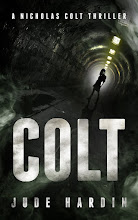Splitting The Scene, Part One: Setting
Is setting important in a novel?
I think it's very important. If we look at the five W's of basic journalism (Who, What, When, Where, Why), two of those elements--when and where--are all about setting. But we're not journalists, you say, we're novelists. Doesn't matter. When and Where anchors the readers, gives them a point of reference in time and space.
An opening scene should divulge, in some manner, the PERIOD in which the novel is set. Barring time travel and flashbacks, your period will follow chronologically from the opening scene. Are we in 1873 or 1973? Ancient Egypt or modern day Manhattan? We can tell the reader the exact date, but in fiction it's always better to show. If your character has a cell phone or a computer, those would be good clues to the period we're in. A black rotary dial phone? A telegraph machine? Smoke signals? Drums? Methods of communication can give your reader a good idea of your period. Even if you do decide to tell the date, showing the technology of the day will make that date seem more real.
Modes of transportation are another good way to show period. Are we in a covered wagon, a DeLorean, or a space ship capable of warp speed? Again, technology gives us a good clue.
Along with period, every scene must have LOCATION. Where the hell are we? Some authors go on for pages describing every detail of a location, but I don't think that's necessary. If you're clever, a few perceptions from your character will show the reader all s/he needs to know. The magnificent view from Mary's 95th floor office suite was suddenly obstructed by the nose of a very large airplane. Okay, that might be cheating a bit, but I think you get the idea. We don't need to describe the view in detail to know exactly where we are. The same principle would apply even in an exotic location like the Amazon jungle. A few telling details, and the reader is there.
What is the DURATION of your scene? Does the action take place over the course of thirty seconds or thirty years? In any case, the reader needs to know. What are some good techniques to show the passage of time within a scene? You tell me.
Next up: Splitting The Scene, Part Two: Point of View
I think it's very important. If we look at the five W's of basic journalism (Who, What, When, Where, Why), two of those elements--when and where--are all about setting. But we're not journalists, you say, we're novelists. Doesn't matter. When and Where anchors the readers, gives them a point of reference in time and space.
An opening scene should divulge, in some manner, the PERIOD in which the novel is set. Barring time travel and flashbacks, your period will follow chronologically from the opening scene. Are we in 1873 or 1973? Ancient Egypt or modern day Manhattan? We can tell the reader the exact date, but in fiction it's always better to show. If your character has a cell phone or a computer, those would be good clues to the period we're in. A black rotary dial phone? A telegraph machine? Smoke signals? Drums? Methods of communication can give your reader a good idea of your period. Even if you do decide to tell the date, showing the technology of the day will make that date seem more real.
Modes of transportation are another good way to show period. Are we in a covered wagon, a DeLorean, or a space ship capable of warp speed? Again, technology gives us a good clue.
Along with period, every scene must have LOCATION. Where the hell are we? Some authors go on for pages describing every detail of a location, but I don't think that's necessary. If you're clever, a few perceptions from your character will show the reader all s/he needs to know. The magnificent view from Mary's 95th floor office suite was suddenly obstructed by the nose of a very large airplane. Okay, that might be cheating a bit, but I think you get the idea. We don't need to describe the view in detail to know exactly where we are. The same principle would apply even in an exotic location like the Amazon jungle. A few telling details, and the reader is there.
What is the DURATION of your scene? Does the action take place over the course of thirty seconds or thirty years? In any case, the reader needs to know. What are some good techniques to show the passage of time within a scene? You tell me.
Next up: Splitting The Scene, Part Two: Point of View


2 Comments:
Hi Jude:
Nothing gets me skimming a book more than reams of scene description. Like you, I prefer to show my readers a few precise details that are important. That's the key. There's a difference between telling me gobs of information to depict something down to precise details that are generally unnecessary, vs. leading my eye to what will be important as I get to know this character. If she's superstitious, for instance, it might be important to know she keeps a dozen Buddhist and religious statues on her desk, and paints her door a certain color. But it may not be important to know that the floors of her office are hardwood. You know?
E
Hi Erica:
Exactly. The setting is important only as it pertains to the POV character. And it's always best, if possible, to incorporate description within action. Actions and reactions propel the scene forward, while static descriptions bring it to a screeching halt.
Post a Comment
Subscribe to Post Comments [Atom]
<< Home